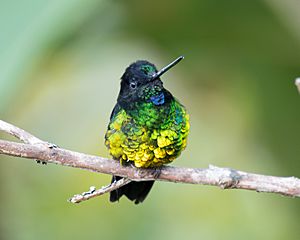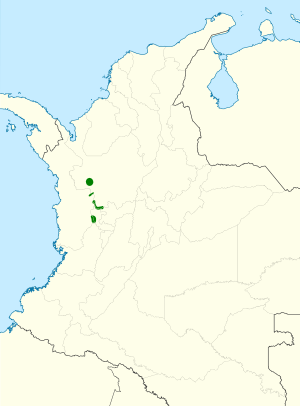Dusky starfrontlet facts for kids
Quick facts for kids Dusky starfrontlet |
|
|---|---|
 |
|
| Conservation status | |
| Scientific classification | |
| Genus: |
Coeligena
|
| Species: |
orina
|
 |
|
The dusky starfrontlet (Coeligena orina) is a special kind of hummingbird. It is also called the glittering starfrontlet. This bird is an Endangered animal, which means there are not many left. It lives only in a few small places in western Colombia.
Contents
Discovering the Dusky Starfrontlet
The dusky starfrontlet was first known from a single bird specimen found in 1951. Scientists described it as a new species in 1953. Later, in 1988, some thought it was just a type of golden-bellied starfrontlet.
But then, in 2004, this bird was found again! It was in a place now called the Colibri del Sol Bird Reserve. More studies showed that it was indeed its own unique species. It is related to other starfrontlet hummingbirds.
What Does the Dusky Starfrontlet Look Like?
The dusky starfrontlet is about 14 cm (5.5 in) long. That's about the length of a pen. Males weigh about 6.9 to 7.2 g (0.24 to 0.25 oz), and females weigh 6.7 to 7 g (0.24 to 0.25 oz). That's lighter than a pencil!
Male Dusky Starfrontlet
Males have a shiny blue-green or golden-green forehead. Their head and upper back are a very dark, velvety black. Their main back feathers are green with black parts. The lower back and tail feathers are a shimmery golden-green. Their tail is a lighter green.
Their throat and chest are dark green, also with black parts. They have a bright, deep blue spot on their lower throat. Their belly and the feathers under their tail are the same golden-green as their lower back.
Female Dusky Starfrontlet
Females have a green head and upper back. The tips of their feathers are blackish, which makes them look a bit scaly. Their lower back, tail feathers, and tail are like the male's, but they don't shimmer as much.
Their throat is a bright, warm orange-brown color. They have green spots on the sides of their throat. Their belly is a shimmery golden-green with some darker spots. The feathers under their tail are a dull golden-green with light brown edges.
One special Spanish name for this bird is "Colibrí del Sol." This means "hummingbird of the Sun."
Where Does the Dusky Starfrontlet Live?
The dusky starfrontlet lives in only about a dozen spots in the Western Andes mountains of Colombia. Some were found in a place called Páramo de Frontino. Others were found in Las Orquídeas National Natural Park. They have also been seen in Jardín and Cerro Montezuma.
These hummingbirds like to live in tall, wet forests. They also live in "elfin forests," which are forests with small, twisted trees. They can also be found where the forest meets a type of grassland called páramo. Most often, they are seen high up in the mountains. This is usually between 3,100 and 3,500 m (10,200 and 11,500 ft) high. One time, a bird was seen a bit lower, at 2,500 m (8,200 ft).
How Does the Dusky Starfrontlet Behave?
Movement
Scientists don't know much about how the dusky starfrontlet moves around. The sighting at a lower elevation might mean that some birds travel to different areas.
Feeding
The dusky starfrontlet drinks nectar from several types of flowers. These include plants from the Aetanthus, Bejaria, Bomarea, Cavendishia, and Centropogon groups. Besides nectar, these birds also eat small insects. Scientists have found spiders, wasps, flies, and other tiny bugs in their stomachs.
Breeding
Not much is known about how the dusky starfrontlet raises its young. Only two nests have been found. Both were in Tatamá National Natural Park. The nests were made on rock faces, held up by thin roots. They were about 3 m (10 ft) above the ground. Each nest had two eggs. Young birds have been seen in both January and August.
Vocalization
The dusky starfrontlet makes a few different sounds. One sound is a high-pitched, thin note that ends like a trill, sounding like "tseeririrrr." It also makes a single "tsee" sound and a lower, sharper "tsip."
Why is the Dusky Starfrontlet Endangered?
The IUCN first thought the dusky starfrontlet was not in danger. But then, in 2007, they changed its status to Critically Endangered. This meant it was in extreme danger. In 2020, its status was changed again to Endangered.
Scientists believe there are only between 250 and 2500 adult birds left. This number is thought to be going down. Even in national parks, its home is threatened. People are cutting down forests for wood, farms, and new towns. There is also a high chance of future mining for gold, zinc, and copper in Páramo de Frontino. These activities pose a big danger to the dusky starfrontlet's survival.
See also
 In Spanish: Colibrí del sol para niños
In Spanish: Colibrí del sol para niños


